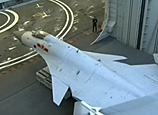
VANCOUVER, April 23 (Xinhua) -- Microraptors, a flying dinosaur about the size of a modern-day hawk, could catch preys in the water as well as on land, according to a Canadian research.
The research, published earlier this week in the journal Evolution, challenged previous belief that microraptors lived in trees and preyed exclusively on small birds and mammals about the size of squirrels.
The new evidence of Microraptor's hunting ability came from fossilized remains in China, in which the stomach content of fish was easily identified, said Scott Persons, a paleontology graduate student at the University of Alberta.
"Now we know that Microraptor operated in varied terrain and had a varied diet," said Persons. "It took advantage of a variety of prey in the wet and forested environment" in the current China terrain during the early Cretaceous period, or 120 million years ago.
Further analysis of the fossil revealed that its teeth were adapted to catching slippery, wiggling preys like fish. Dinosaur researchers have established that most meat-eaters had teeth with serrations on both sides, which helped the predator saw through meat like a steak knife.
But the Microraptor's teeth were serrated on just one side, and were angled forward. It is another evidence that shows Microraptor's adaption to impale fish on its teeth.
"With reduced serrations, the prey wouldn't tear itself apart while it struggled," said Persons. "Microraptor could simply raise its head back; the fish would slip off the teeth and be swallowed whole, no fuss, no muss."
















 China’s weekly story
China’s weekly story
(2013.4.13-4.19)


![]()
